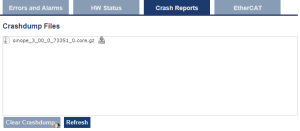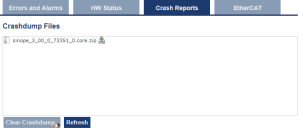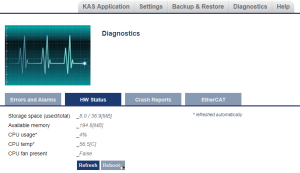Web Server Diagnostic
This page displays information about the hardware status (e.g., storage space, memory, and CPU temperature) and errors and alarms.
Errors and Alarms
The Errors and Alarms tab and on the 7-segment display shows any controller errors or alarms generated by the system.
| Controller | Description |
|---|---|
| Storage Space |
This is both the used and total available amount of storage space in megabytes (MB).
|
| Available Memory | This is the amount of RAM memory available on the Controller. |
| CPU usage |
This is the current load on the CPU.
|
| CPU Temp |
This is the temperature of the CPU in Celsius.
|
| CPU Fan Present | This is either True or False, depending if there is a CPU fan present in the controller. |
| Refresh |
Click this button to refresh the Hardware Status information. |
| Reboot |
Click this button to reboot the web server. |
-
- A common error or alarm is due to the flash memory being full.
This is often caused by heavy use of the PLC "Programmable Logic Controller"
A Programmable Logic Controller, PLC, or Programmable Controller is a digital computer used for automation of industrial processes, such as control of machinery on factory assembly lines.
Used to synchronize the flow of inputs from (physical) sensors and events with the flow of outputs to actuators and events Advanced File function blocks.
"Programmable Logic Controller"
A Programmable Logic Controller, PLC, or Programmable Controller is a digital computer used for automation of industrial processes, such as control of machinery on factory assembly lines.
Used to synchronize the flow of inputs from (physical) sensors and events with the flow of outputs to actuators and events Advanced File function blocks.
Some errors or alarms are only cleared by powering off and restarting the Kollmorgen controller.
- The Refresh button updates the list.
- The Clear button removes the contents of this tab.
See AKD PDMM, PCMM, and PCMM2G Errors and Alarms for a complete list of codes.
-
-
Axis errors can be seen in the KAS Application Axis tab.
Hardware Status
-
-
Do not try to refresh the web page until the server has rebooted.
Crash Reports
The files shown on the Crash Reports tab are reports of the process that failed if there is a crash.
-
- These archives may be sent to Kollmorgen for analysis:
.GZ for AKD PDMM and PCMM.ZIP for PCMM2G

Figure 6-12: AKD PDMM and PCMM |

Figure 6-13: PCMM2G |








